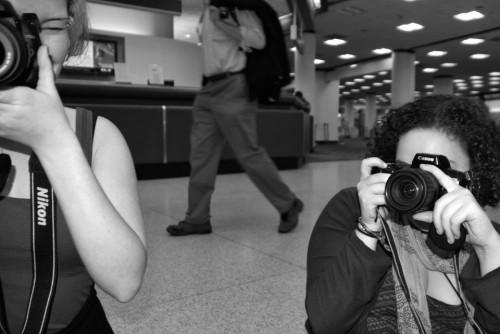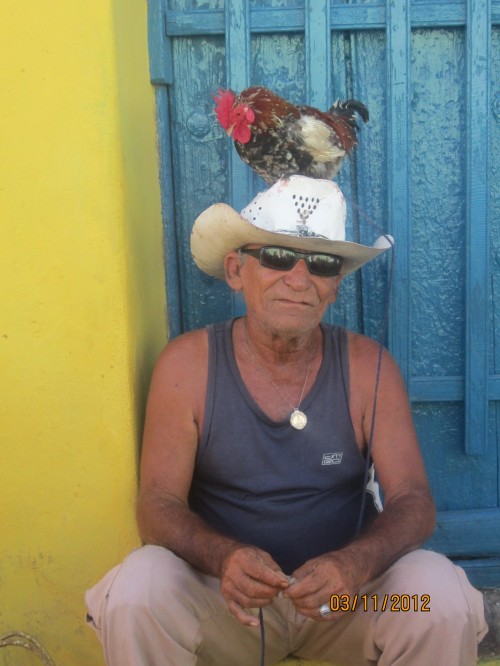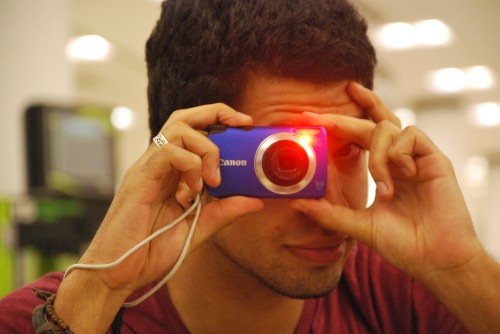Click-Click-Click.
May 3, 2012 by nialexandre
There’s perhaps no greater insignia of tourism than the camera. The stereotypical image of any tourist, regardless of country and culture, invariably includes a camera hanging from a neck or firmly grasped in hand. Today, the first thing we do upon arrival in a new country – after we’ve located our luggage and potentially the bar – is bring a camera to our eyes and begin shooting pictures. The alternative option is to feel regret because we’ve forgotten our camera, or it broke en route, or the battery’s out, at which point we feel hollow and destitute. The idea of going on a vacation without a camera is now a foreign concept, and yet we occasionally get the urge to leave those cameras at home, which somehow gives us a rebellious kick (as if we were disobeying mother and eating that extra cookie). Usually though, this tends to be a fleeting feeling and instead we give into the much more comfortable option of taking our camera along for the ride and firing at will (usually not what happens with the cookie).
Susan Sontag, one of the leading – and slightly depressing – writers of photography theory discusses how the act of taking a picture is intimately connected with our conscious acceptance of the limited amount of time in the space we visit. “All photographs are memento mori. To take a photograph is to participate in another person’s (or thing’s) mortality, vulnerability, mutability. Precisely by slicing out this moment and freezing it, all photographs testify to time’s relentless melt.” We take a picture in part because we recognize that was is in front of us will fade, or that we will leave it, and somehow even though we accept time we can’t seem to ever embrace its relentlessness (when we’re not in class that is; at which point we’re down on our knees begging Chronos to marry us). This call to the picture is perhaps even stronger in a foreign country so different from our own, particularly when we don’t see ourselves ever returning to it.
We may have crossed Cuba’s borders as tourist on an educational trip, but in the eye of the camera it made no difference what we were there for. In an attempt to record everything we experienced, we left Cuba with GBs and GBs of pictures. This wasn’t anything new, many of the places we visited acknowledged the picture taking power of tourists; from men in the streets of Santa Clara who wore roosters on their heads in hopes of exchanging the image for a CUC, to the necessity of paying to bring cameras into certain areas, to the outright ban of cameras at Che’s memorial. Invariably, a majority of the daylight hours was spent relating to Cuba through a lens, taking picture after picture in a mix of excited enthusiasm and a fear of missing the occasion to record something important. Seeing it wasn’t nearly as important as saving it for posterity. In the evenings, when we were no longer tied to a scheduled timetable and were set free to discover, dance, and drink, the camera seemed to vanish (the eternal questions of ‘where do I put my camera if we go dancing’ and the ‘there’s no light anyways’ not withstanding) as we slowly started to participate more and record less.
It was particularly interesting to see how the government’s relationship to tourists’ cameras changed based on the site we were visiting. Although we did have to pay a small fee to bring camera’s into Havana’s cemetery, we were encouraged to take pictures of the monuments and mausoleums. In contrast, Che’s memorial and museum strictly banned cameras out of respect for Cuba’s fallen hero. Did it not matter that we disrespect the nameless tombs of Cuba’s citizens, since we didn’t know their stories or how they contributed to Cuba’s survival as a nation? Che site’s, on the other hand, as the resting place of an iconic figure for Cuba and, to an extent, the world, demanded that we respectfully acknowledge his story by giving it our full attention, unaffected by the physical and mental distance a camera demands.
One of Sontag’s main argument in her book On Photography is how the camera creates a habit of recording in lieu of intervening. At any given point in time, one can chose to take a picture, or to live the experience. She states, in very practical terms, that “photographs are a way of imprisoning reality…One can’t possess reality, one can possess images–one can’t possess the present but one can possess the past.” This is a somewhat depressing way of viewing photography as an egocentric, unnatural action meant only to benefit the self, but this is not necessarily the case. Many of us were blown away by what we saw in Cuba, and although finding ways to remember it was on the top of our list, bringing these images to other people was also in our minds. There’s a difference between posing in front of a well recognized monument or scene for the sake of proving to ourselves and the world that we were there (the taking of the pictures itself is an anonymous act), and getting a picture without ourselves to release into the world so other people can benefit and maybe learn from that image. And in between those two extremes is the picture taking of our friends, of the people that shared our overarching experience there – a recognition of a communal memory, a token to keep warm by on a winter’s night.
Framing photography is a tricky endeavor at best. Pictures can be used to promote one’s ego, to hide behind when confronted with an uncomfortable, or even traumatizing experience, to educate and inform, and/or simply to remember. Yet the unifying factor of all of these is that they remove the photographer slightly from wherever they are and whatever is happening – they are no longer in the moment, if only for a brief snapshot of time. Tough life, in order to see anything at all you have to be removed from it. My own relationship to the rapid-fire, digital world of picture taking is convoluted. I have that desire to record as much as possible when I arrive in a personally uncharted territory. Yet growing up with a father-photographer who uses almost exclusively film and who repeatedly deplored the habit of ‘these young people’ for taking a 100 of pictures to keep only 3 of them has definitely made me appreciate the prospect of experiencing a place as much as possible and the, only when absolutely necessary, taking a well thought out picture. There are no doubt ties to a society that has no time for anything anymore, but nevertheless, if photography is an extension of how we see, and we base our lives on what we see, maybe there’s something to be said for the old folk’s habit of experiencing first, and claiming the moment for later…well, later.
“The camera makes everyone a tourist in other people’s reality, and eventually in one’s own.” – Susan Sontag, On Photography.
Leave a Reply
You must be logged in to post a comment.


